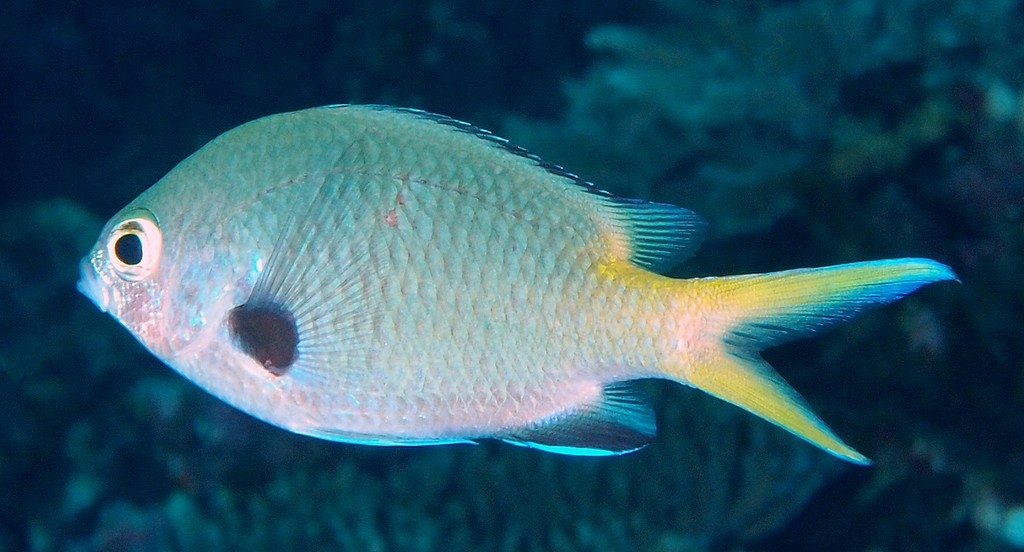CHROMIS KENNENSIS - (WHITLEY, 1964)
Actinopterygii (Gigaclass) > Actinopteri (Class) > Teleostei (Subclass) > Blenniiformes (Order) > Pomacentridae (Family) > Chrominae (Subfamily) > Chromis (Genus)
Demoiselle chromis à queue jaune, Chromis à point jaune, Yellow-spotted Chromis, Yellowspot Puller, Yellow-tail Puller, 肯礁光鰓魚, 肯礁光鳃鱼,
Description
Dorsal spines (total): 13; Dorsal soft rays: 11-13 (usually: 12); Anal spines: 2; Anal soft rays: 10-12 (usually: 11); Pectoral fin rays: 17-21 (usually: 19); Principal caudal fin rays: 15; Spiniform caudal fin rays: 2; Scale rows in longitudinal series: 24-27 (usually: 26); Tubed lateral line scales: 15-19 (usually: 18); Scale rows above lateral line: 3, Scale rows below lateral line: 9-10 (usually: 9); Gill rakers: 7-9 (usually: 8) + 21-25 (usually: 24) = 29-34 (usually: 32); Preopercular margin smooth; Caudal fin deeply forked, without prolonged filaments; Basal width of pelvic fin axillary scale: 0.6-1.8 % of SL; Basal width of scale between pelvic fin bases: 2.0-2.8 % of SL. Max. length: 10.0 cm SL. Depth range: 2 - 35 m.
Color
Prominent black blotch covering entire pectoral fin base throughout life; No white spot at end of dorsal fin base; caudal peduncle without distinct markings; caudal fin yellowish with no dark band along each fin lobe.
Dorsal spines (total): 13; Dorsal soft rays: 11-13 (usually: 12); Anal spines: 2; Anal soft rays: 10-12 (usually: 11); Pectoral fin rays: 17-21 (usually: 19); Principal caudal fin rays: 15; Spiniform caudal fin rays: 2; Scale rows in longitudinal series: 24-27 (usually: 26); Tubed lateral line scales: 15-19 (usually: 18); Scale rows above lateral line: 3, Scale rows below lateral line: 9-10 (usually: 9); Gill rakers: 7-9 (usually: 8) + 21-25 (usually: 24) = 29-34 (usually: 32); Preopercular margin smooth; Caudal fin deeply forked, without prolonged filaments; Basal width of pelvic fin axillary scale: 0.6-1.8 % of SL; Basal width of scale between pelvic fin bases: 2.0-2.8 % of SL. Max. length: 10.0 cm SL. Depth range: 2 - 35 m.
Color
Prominent black blotch covering entire pectoral fin base throughout life; No white spot at end of dorsal fin base; caudal peduncle without distinct markings; caudal fin yellowish with no dark band along each fin lobe.
Etymology
Chromis: from Greek, chroemo = to neigh. A name dating to Aristotle, referring to a drum (Sciaenidae) and its ability to make noise; Later applied to this damselfish and subsequently expanded to embrace dottybacks, cichlids and wrasses (all perch-like fishes once thought to be related).
kennensis: from Kenn Reef, Coral Sea, Australia. The type locality for this fish.
Orginal description: Chromis kennensis Whitley, 1964 - Type locality: Kenn Reef, Coral Sea; October 2, 1960. Dr. D. F. McMichael.
Distribution
Southwest Pacific Ocean: Coral Sea, Lord Howe Island, eastern Australia, New Caledonia and Tonga.
Biology
Adults inhabit lagoon and outer coral reefs, boulder bottoms and lava cliffs, in small to large aggregations. Oviparous, distinct pairing during breeding. Eggs are demersal and adhere to the substrate. Males guard and aerate the eggs.
Similar species
Chromis: from Greek, chroemo = to neigh. A name dating to Aristotle, referring to a drum (Sciaenidae) and its ability to make noise; Later applied to this damselfish and subsequently expanded to embrace dottybacks, cichlids and wrasses (all perch-like fishes once thought to be related).
kennensis: from Kenn Reef, Coral Sea, Australia. The type locality for this fish.
Orginal description: Chromis kennensis Whitley, 1964 - Type locality: Kenn Reef, Coral Sea; October 2, 1960. Dr. D. F. McMichael.
Distribution
Southwest Pacific Ocean: Coral Sea, Lord Howe Island, eastern Australia, New Caledonia and Tonga.
Biology
Adults inhabit lagoon and outer coral reefs, boulder bottoms and lava cliffs, in small to large aggregations. Oviparous, distinct pairing during breeding. Eggs are demersal and adhere to the substrate. Males guard and aerate the eggs.
Similar species
- Chromis katoi (Iwatsubo & Motomura, 2018) - Reported from Northwestern Pacific: southern Sea of Japan and Izu Islands (Japan).
- Chromis notata (Temminck & Schlegel, 1843) - Reported from Western Pacific: northern Vietnam, southern China and Taiwan north to Korea, Japan and Ogasawara Islands.
- Chromis pura (Allen & Randall, 2004) - Reported from Western Pacific: eastern Indonesia.
- Chromis yamakawai (Iwatsubo & Motomura, 2013) - Reported from Western Pacific: Philippines and Taiwan north to Japan.
Last update: 20, September 2021
